
Planetary Astronomy
This is both an observational and a theoretical science. Observational researchers are predominantly concerned with the study of the small bodies of the solar system: those that are observed by telescopes, both optical and radio, so that characteristics of these bodies such as shape, spin, surface materials and weathering are determined, and the history of their formation and evolution can be understood. Theoretical planetary astronomy is concerned with dynamics: the application of the principles of celestial mechanics to the Solar System and extrasolar planetary systems.
What is a Planetary System?
A planetary system is a set of gravitationally bound non-stellar objects in orbit around a star or star system. Generally speaking, planetary systems describe systems with one or more planets, although such systems may also consist of bodies such as dwarf planets, asteroids, natural satellites, meteoroids, comets and planetesimals as well as discernable features including circumstellar disks. The Sun together with its planetary system, which includes Earth, is known as the Solar System. The interchangeable terms extrasolar system and exoplanetary system are sometimes used in reference to other planetary systems. Individually they may be referred to as system prefixed by the name of the star or star system that it orbits or sometimes simply the name of the star system.
Before the 16th century and Copernican heliocentrism, human knowledge of planetary systems was limited to heliocentrism and our own planetary system (the Solar System). Despite the discovery and exploration of the Solar System and centuries of conjecture, it remained this way until the groundbreaking discovery of the unusual PSR B1257+12 system and its extrasolar planets, confirmed in 1992, which holds a number of significant records, including the first discovered, as well as the first pulsar, multi-star planetary system.
The 21st century has become a golden era of planetary system discovery, with findings occurring at a rapid rate. A total of 908 such planets (in 700 planetary systems, including 140 multiple planetary systems) have been identified as of 6 July 2013. Hundreds more systems are unconfirmed. In terms of total confirmed planets, the Solar System with 8 remains the largest planetary system. However, HD 10180 has a total of 7 confirmed planets and a total of 2 unconfirmed planets, which would bring the total to 9, and is currently the largest known exoplanetary system. A wide range of planetary systems have been discovered, with a variety of different orbital arrangements around different types of stars. The closest confirmed system is Gliese 832 at 14.8 light years (ly) with one confirmed planet, whereas the closest unconfirmed system is Alpha Centauri at 4.37 ly with a planet of Earth mass. The closest multi-planet system is Gliese 876 at 15.3 ly with four confirmed planets.
While knowledge of the nature of planetary systems including our own has increased considerably, much is unknown of their origin and evolution and current theories of their formation and evolution are relatively new to the field of planetary science.
Of particular interest to astrobiology is the habitable zone of planetary systems, believed to be the region with the most potential to develop and sustain extraterrestrial life.
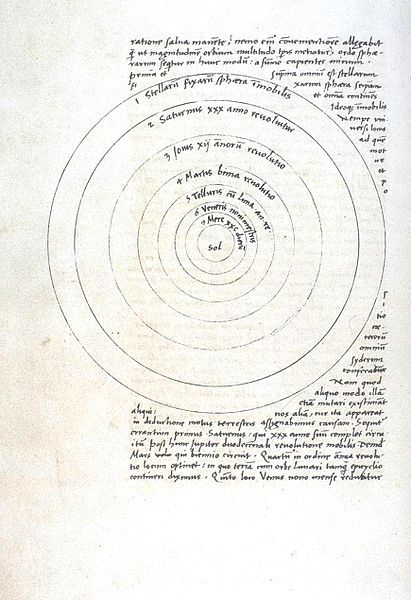
Heliocentrism
Historically, heliocentrism (that the sun was the centre of the universe) was opposed to geocentrism, which placed the Earth at the center of the universe. The notion of a heliocentric solar system, with the Sun at the center, is possibly first suggested in the Vedic literature of ancient India, which often refer to the Sun as the “centre of spheres”. Some interpret Aryabhatta’s writings in Āryabhaṭīya as implicitly heliocentric. The idea was first proposed in western philosophy and Greek astronomy as early as the 3rd century BC by Aristarchus of Samos, but had received no support from most other ancient astronomers.
Speculation on extrasolar planetary systems
In the 16th century the Italian philosopher Giordano Bruno, an early supporter of the Copernican theory that the Earth and other planets orbit the Sun, put forward the view that the fixed stars are similar to the Sun and are likewise accompanied by planets. He was burned at the stake for his ideas by the Roman Inquisition.
In the 18th century the same possibility was mentioned by Isaac Newton in the “General Scholium” that concludes his Principia. Making a comparison to the Sun’s planets, he wrote “And if the fixed stars are the centers of similar systems, they will all be constructed according to a similar design and subject to the dominion of One. His theories gained traction through the 19th and 20th centuries despite a lack of supporting evidence. Long before their confirmation by astronomers, conjecture on the nature of planetary systems had been a focus of Search for extraterrestrial intelligence and has been a prevalent theme in fiction, particularly science fiction.
Detection of exoplanets
The first confirmed detection of a planetary system was in 1992, with the discovery of several terrestrial-mass planets orbiting the pulsar PSR B1257+12. The first confirmed detection of planetary system of a main-sequence star was made in 1995, when a giant planet, 51 Pegasi b, was found in a four-day orbit around the nearby G-type star 51 Pegasi. The frequency of detections has increased since then, particularly through advancements in methods of detecting extrasolar planets and dedicated planet finding programs such as the Kepler mission.
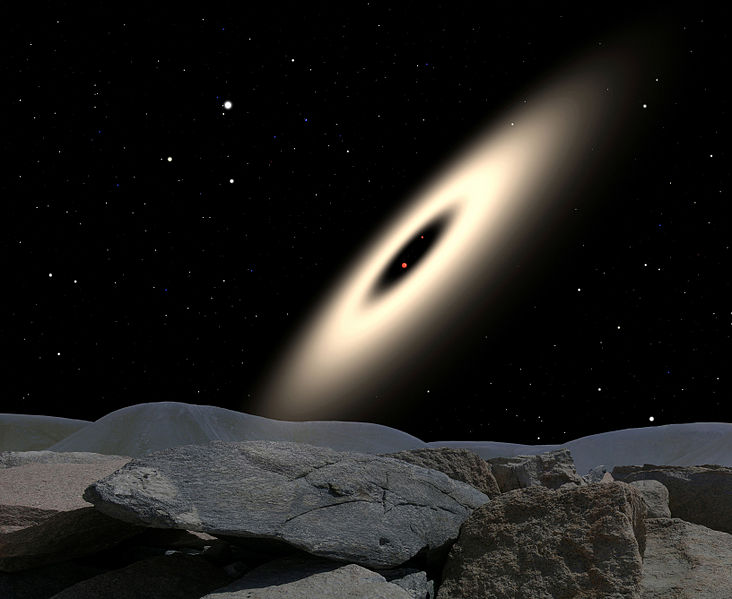
Origan and Evolution
Early theories of planetary systems were based on knowledge of the formation and evolution of the Solar System. Planetary systems are generally believed to form as part of the same process which results in star formation. Some early theories involved another star passing extremely close to the star, drawing material out from it which then coalesced to form the planets. However, the probability of such a near collision is now known to be far too low to make this a viable model. Accepted theories today argue that a protoplanetary disk forms by gravitational collapse of a molecular cloud and then evolves into a planetary system by collisions and gravitational capture.
Some planetary systems may form differently, however. Planets orbiting pulsars—stars which emit periodic bursts of electromagnetic radiation—have been discovered by the slight variations they cause in the timing of these bursts. Pulsars are formed in violent supernova explosions, and a normal planetary system could not possibly survive such a blast—planets would either evaporate, be pushed off of their orbits by the masses of gas from the exploding star, or the sudden loss of most of the mass of the central star would see them escape the gravitational hold of the star. One theory is that existing stellar companions were almost entirely evaporated by the supernova blast, leaving behind planet-sized bodies. Alternatively, planets may somehow form in the accretion disk surrounding pulsars.
The formation of planetary systems has also been found to be linked to stellar classification. Stars are composed mainly of the light elements hydrogen and helium. They also contain a small proportion of heavier elements such as iron, and this fraction is referred to as a star’s metallicity. Stars of higher metallicity are much more likely to form and retain planetary systems, and the planets within them tend to be more massive than those of lower-metallicity stars. It has also been shown that stars with planets are more likely to be deficient in lithium. Recent observations by the Spitzer Space Telescope indicate that planetary formation does not occur around other stars in the vicinity of an O class star due to the photoevaporation effect.
Models of the Solar System point to material being ejected during the formation and early evolution as the system stabilised. Similar interactions are thought to be common to many planetary systems. The orbits of large bodies are being established; they may migrate and cause planetary body collisions. Others may be sufficiently perturbed to be ejected completely from the system. These ejected bodies are known as rogue planets and may retain their natural satellites. Systems such as these in interstellar space, known as planetars, may orbit the galaxy directly and although difficult to detect are now thought to be extremely common.

Types and Attributes
With the increasing discovery of planetary systems, astronomers have begun to classify them by type. In particular, as certain types of stars are now known for producing specific types of planetary systems, they are classified by the spectral type of the host star. Main-sequence stars like the Sun (spectral type G or K), for example, have represented the majority of planetary system discoveries. Additionally, they are often classified by the size and types of planets and their orbital configuration. Hot Jupiter systems with a gas giant very close to the star are one of the most common found so far and Hot Neptune type systems have also been found. Theories, such as scattering, have been proposed for the formation of large planets close to their parent stars. Dusty disks with a wide ring of dust and comets are another common type of system. Protoplanetary disks, still in the process of forming have also been discovered. At present, few systems have been found to analogues of our own with terrestrial planets close to the parent star. More commonly, systems consisting of multiple Super-Earths have been detected.
Multiplanet Systems
140 systems (including the Solar System) are now known to consist of two or more planets. In terms of total confirmed planets, the Solar System with 8 remains the largest planetary system and HD 10180 with 7, the second largest. 55 Cancri was for some time the largest known system. Some systems, such as HD 10180 and Gliese 581 contain multiple unconfirmed planets pushing the total expected number of planets to be discovered in their systems higher. If HD 10180’s two candidate planets are confirmed, it would be the largest by number of known planets with a total of 9.
Orbital Properties
Unlike the Solar System, which has coplanar and circular orbits, many of the known planetary systems display much higher orbital eccentricity and some consist of planets in dramatic elliptical orbits while some consist of planets on inconsistent orbital inclination. An example of such a system is 16 Cygni. Although no planets in the Solar System are completely tidally locked, planets with regular orbits in close to their primary stars are thought to typically experience tidal locking. aaSome systems also appear to display orbital resonances. Gliese 876, for example has a 3-body Laplace resonance. Kepler-9 has two planets in mean motion resonance, the first transiting planets discovered with such a resonance.
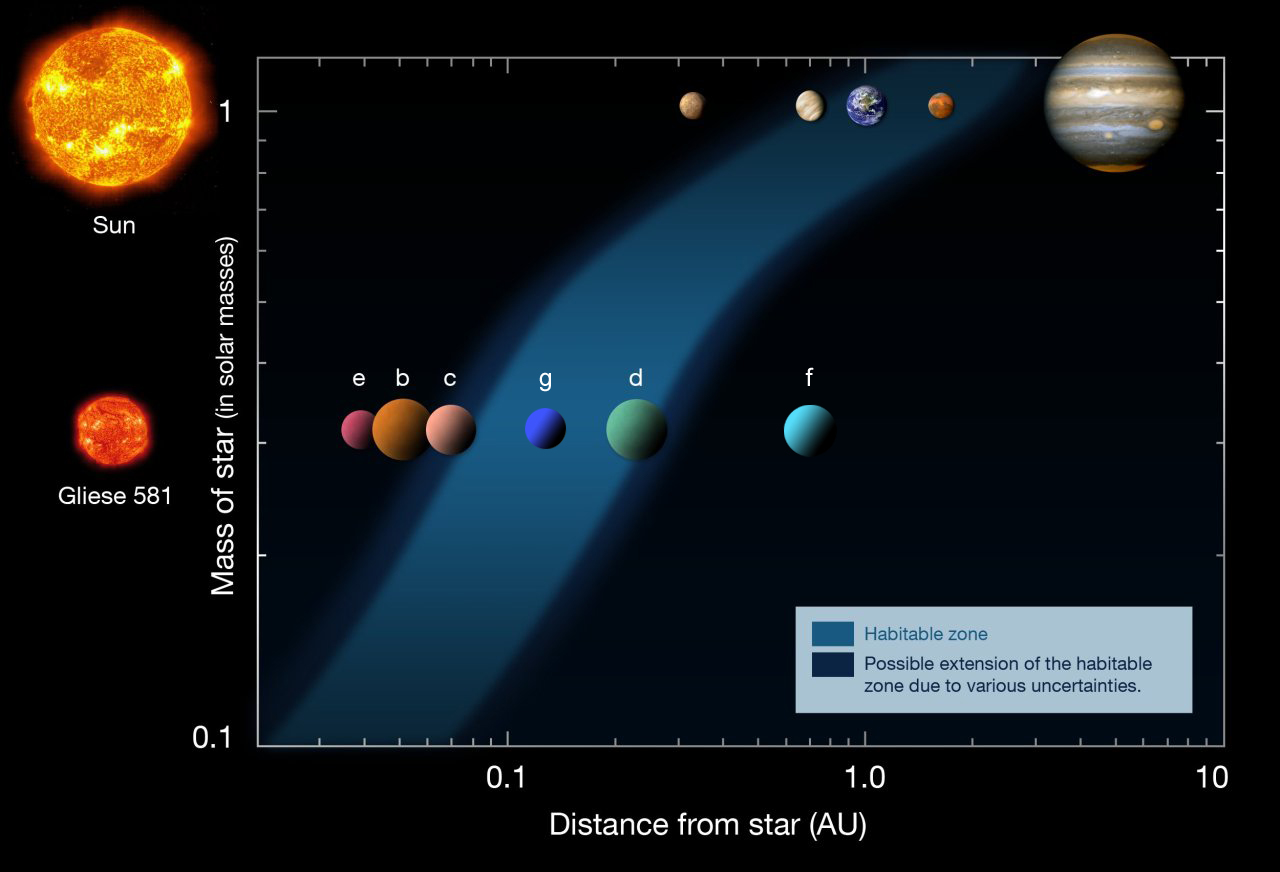
Habitable Zones
The habitable zone is the region in the planetary system where an Earth-like planet (or moon) could maintain liquid water on its surface and potentially therefore, life. The distance of this zone from the parent star can vary greatly from system to system. The lack of surface water on Mars, Venus, the Moon, and Ceres, which according to some estimates lie within the habitable zone of the Solar System, does not exclude the possibility of extraterrestrial surface life in the Solar System but makes it highly unlikely. However the abundance of Life on Earth makes the habitable zones of exoplanetary systems of particular interest to exobiologists and the Search for extraterrestrial intelligence. Gliese 581 was the first exoplanetary system found with Super-Earths in the habitable zone. HD 37124 has multiple known planets in the zone. Systems with gas giants have more commonly discovered in the habitable zone, though they could possibly harbour Earth-like natural satellites.
Main Sequence Systems
The Solar System was the first planetary system known around a main-sequence star. As such, main-sequence systems are of particular interest to science due to the prospect of finding true analogs to the Solar System, along with true Earth analogs and therefore possibly Earth-like complex or even intelligent life.
The first main-sequence exoplanetary system found was Upsilon Andromedae in April 1999. Since then, several further systems have been discovered. Many have been found to bear similarities to our own, for example the first terrestrial planets of comparable size to Earth (in the Kepler-20 system) and planets close to Earth sized but much larger (Super-Earths) have even been located in habitable zones in the HD 85512 and Kepler 22 systems. Discoveries to date indicate that our Solar System’s arrangement of all the terrestrial planets arranged closest to the sun and the giant planets further out is unlikely to be the general rule. This challenges well established theories of their formation and evolution suggesting that early migration of giant planets could causes wide variations in the arrangement of main-sequence systems.
Three of the nearest main-sequence stars to the Sun are now thought to host planetary systems. This includes the nearest main-sequence star to Earth at 4.37ly, Alpha Centauri A which was found in 2012 to have an Earth-sized planet in close orbit around it. Unconfirmed planetary systems include the Epsilon Eridani system at 10.5ly from Earth and the Tau Ceti system at 11.905ly, both believed to have multiple detected planets.
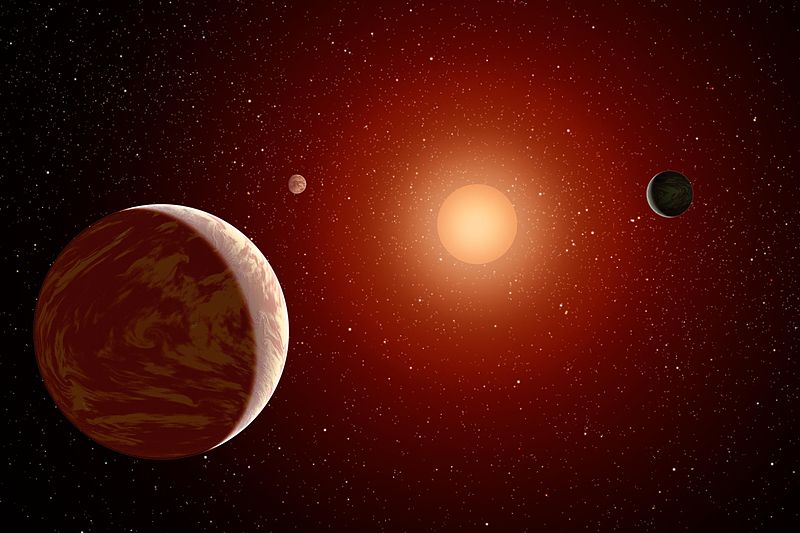
Red Dwarf Systems
Red dwarf systems orbit red dwarfs, stars which may represent 70% to more than 90% of the stars in the galaxy. The Gliese 876 was the first such system discovered in 1998. Most planets of these systems are thought to be tidally locked. This and high stellar variation are postulated to be major impediments to planetary habitability. Gliese 581 is another well known red dwarf system which is speculated to have multiple planets within the habitable zone.
Brown Dwarf Systems
Brown dwarf planetary system orbit brown dwarfs. 2M1207, the first planetary system to be imaged, was also the first such system discovered. Some companions of brown dwarfs, such as those of 2M1207 and GQ Lupi, are thought to have formed by cloud collapse rather than accretion, and hence these are sometimes considered sub-brown dwarfs rather than planets. Disks around brown dwarfs have been found to have many of the same features as disks around stars; therefore, it is expected that there will be accretion-formed planets around brown dwarfs. Given the small mass of brown dwarf disks, most planets will be terrestrial planets rather than gas giants. It is now believed that many brown dwarfs may have planets and also, possibly, a shortly lived habitable zone. Most planets of these systems are thought to be tidally locked.
Sub-brown Dwarf Systems
Rogue systems are systems that are not gravitationally bound to any star and that therefore orbit the galaxy directly. Some astronomers have estimated that there may be twice as many Jupiter-sized rogue planets as there are stars. Isolated planetary-mass objects which were not ejected from a star’s orbit, may have formed in a similar way to stars. The IAU has proposed that those objects be called sub-brown dwarfs. It is theorised that objects ejected from a planetary system could retain a system of satellites.
Cha 110913-773444 is an example of a rogue system with a protoplanetary disk speculated to contain as many as 4 satellites. It is unknown whether it is ejected planet, or formed on its own.
Pulsar Systems
Pulsar systems orbit pulsars, or rapidly rotating neutron stars. PSR B1257+12 was not only the first pulsar exoplanetary system but also the first planetary system discovered. PSR B1620-26 is also confirmed, however many other pulsar systems remain unconfirmed. The formation of pulsar systems is still the subject of research. It is thought that planets form from the debris of companion stars.
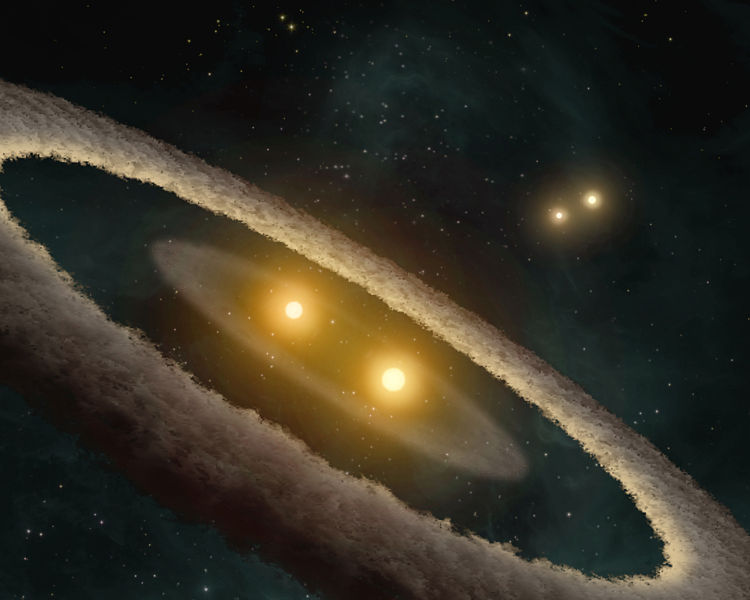
Multiple Star Systems
Multiple star systems, including binary stars are abundant in the Milky Way Galaxy and several are now known to possess planetary systems. The discovery of such systems however creates new challenges on theories on planetary system formation. Prior to the groundbreaking 1993 discovery of the first known planet PSR B1620-26 b in the binary system PSR B1620-26, the possibility of the existence of such systems was long theorised and debated. Chinese-American astrophysicist Su-Shu Huang had dampened expectations of planets forming or remaining in such systems in his 1959 paper “Life-Supporting Regions in the Vicinity of Binary Systems” claiming that due to orbital instability planets and in particular habitable planets would likely be rare. The film Star Wars, however captured the imagination of popular culture with its “twin sun” scene on Tatooine. PSR B1620-26 was not only the first binary system (and multistar system) found with a planet but the first found in which the planet orbited both stars (i.e. in circumbinary orbit, a circumbinary planet).
16 Cygni, discovered in 1996 was the first confirmed triple star planetary system found however the planet orbits just one of the stars – 16 Cygni B. In 2011, the Kepler-16 system was found to have a circumbinary planet within its habitable zone, leading to the Smithsonian Center informally referring to it as “Tatooine” in reference to Star Wars.
This type of planetary system is of particular interest due to Alpha Centauri A being the closest main-sequence star to Earth but also a binary (Alpha Centauri AB) contained within a triple star system. The notion of planets in the Centauri system has been a popular theme in fiction. In 2012 Alpha Centauri B was found to have an Earth-sized planet in orbit around it, increasing expectations of more terrestrial planet discoveries in this and similar systems. PH1, confirmed in 2012, is the first quadruple star planetary system confirmed. NN Serpentis and HW Virginis are notable multi-planet multi-star systems.
Transiting Systems
Transiting planetary systems are those with multiple planets in orbital planes along the line of sight between their star and Earth. The transit method is one of the most successful Earth-centric observation methods. The Kepler mission was designed to discover systems of this type and has found numerous candidate systems. Kepler-11 is a prominent example of a transiting system in which multiple simultaneous planetary transits have been observed. Transiting systems can be studied to not only discover planets, but through Astronomical spectroscopy and Transit timing effects accurately analyse the properties of the systems including the detection of extraterrestrial atmospheres, dust or asteroid belts and possibly natural satellites.